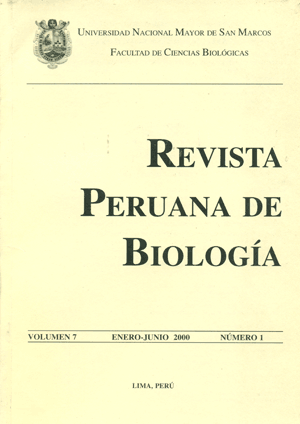Characteristics of infection of Diplectanum sp. (Monogenea: Monopisthocolytea: Diplectanidae) in Cynoscion analis Jenyns (Pisces: teleostei: Scianidae)
DOI:
https://doi.org/10.15381/rpb.v7i1.6727Keywords:
Cynoscion analis, Monogenean, Diplectanum, parasites.Abstract
120 Cynoscion analis Jenyns were collected from Chorrillos fishmarket, Lima, Perú, between January and February 2000 and necropsied to study ectoparasite monogenean Diplectanum sp. from branchial filaments. This parasite was considered a core specie, because it parasites 2/3 hosts examined. Of the fishes collected 80 were female and 40 male. Females and males showed a standard length between 16,4-27,0 cm (mean = 21,08 ± 2,24) and 16,5-26,3 cm (mean = 20,47 ± 2,06), respectively. The prevalence of infection of Diplectanurn was 72,5%, mean intensity and abundance were 3,16 ± 2,84 and 2,29 ± 2,80 respectively. This monogenean showed an overclispersal spatial distribution (2,55) at level of fish hosts. We observed a correlation between mean intensity of infestation and standard length of C. analis. Males (4,14 ± 3,75) showed a higher mean intensity than females (2,67 ± 2,14). A high prevalence, intensity and abundance of Diplectanum to 11 gill was found. However, we did not find neither preference when we separated each gill in three parts (fore, middle and hind respectively). Finally, we compared our results of population assemblages of other ectoparasite monogeneans in marine fishes. Diplectanurn sp. is a new record to C. analis and to Peru.Downloads
Downloads
Published
Issue
Section
License
Copyright (c) 2000 José Iannacone, Wilfredo Mejía, Francisco Alcócer, Gian Briones, Amid Román

This work is licensed under a Creative Commons Attribution-NonCommercial-ShareAlike 4.0 International License.
AUTHORS RETAIN THEIR RIGHTS:
a. Authors retain their trade mark rights and patent, and also on any process or procedure described in the article.
b. Authors retain their right to share, copy, distribute, perform and publicly communicate their article (eg, to place their article in an institutional repository or publish it in a book), with an acknowledgment of its initial publication in the Revista Peruana de Biologia.
c. Authors retain theirs right to make a subsequent publication of their work, to use the article or any part thereof (eg a compilation of his papers, lecture notes, thesis, or a book), always indicating its initial publication in the Revista Peruana de Biologia (the originator of the work, journal, volume, number and date).


















